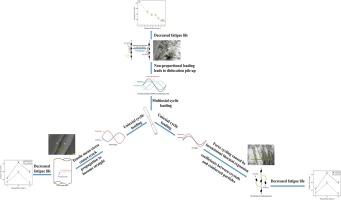不同单轴/多轴热机械加载模式下 Ti60 的损伤机理
IF 5.7
2区 材料科学
Q1 ENGINEERING, MECHANICAL
引用次数: 0
摘要
在不同单轴/多轴热机械加载模式下对钛合金 Ti60 进行的疲劳实验发现,高温和拉应力的共同作用会引起晶界间第二相强化颗粒的脱粘,降低 Ti60 的抗变形能力,从而导致材料的疲劳寿命下降。此外,平均拉应力会增加裂纹突破晶间壁垒的能力,多轴加载引起的非比例附加硬化会加剧微裂纹的形成。两者都会增加材料的疲劳损伤。本次研究确定的疲劳损伤机理可以合理解释高温多轴加载、单轴和多轴热机械疲劳加载下的疲劳寿命规律。本文章由计算机程序翻译,如有差异,请以英文原文为准。

Damage mechanisms of Ti60 under different uniaxial/multiaxial thermo-mechanical loading modes
The fatigue experiments for titanium alloy Ti60 under different uniaxial/multiaxial thermo-mechanical loading modes found that the combined action of high temperature and tensile stress can cause the debonding of the second phase strengthening particles between grain boundary, reducing the ability to resist deformation of Ti60, which leads to a decrease in the fatigue life of the material. In addition, mean tensile stress increases the ability of cracks to break through intergranular barriers and the non-proportional additional hardening caused by multiaxial loading exacerbates the formation of microcracks. Both will increase the fatigue damage of the material. The fatigue damage mechanism identified in this investigation can reasonably explain the fatigue life law under multiaxial loading at high temperature, uniaxial and multiaxial thermo-mechanical fatigue loadings.
求助全文
通过发布文献求助,成功后即可免费获取论文全文。
去求助
来源期刊

International Journal of Fatigue
工程技术-材料科学:综合
CiteScore
10.70
自引率
21.70%
发文量
619
审稿时长
58 days
期刊介绍:
Typical subjects discussed in International Journal of Fatigue address:
Novel fatigue testing and characterization methods (new kinds of fatigue tests, critical evaluation of existing methods, in situ measurement of fatigue degradation, non-contact field measurements)
Multiaxial fatigue and complex loading effects of materials and structures, exploring state-of-the-art concepts in degradation under cyclic loading
Fatigue in the very high cycle regime, including failure mode transitions from surface to subsurface, effects of surface treatment, processing, and loading conditions
Modeling (including degradation processes and related driving forces, multiscale/multi-resolution methods, computational hierarchical and concurrent methods for coupled component and material responses, novel methods for notch root analysis, fracture mechanics, damage mechanics, crack growth kinetics, life prediction and durability, and prediction of stochastic fatigue behavior reflecting microstructure and service conditions)
Models for early stages of fatigue crack formation and growth that explicitly consider microstructure and relevant materials science aspects
Understanding the influence or manufacturing and processing route on fatigue degradation, and embedding this understanding in more predictive schemes for mitigation and design against fatigue
Prognosis and damage state awareness (including sensors, monitoring, methodology, interactive control, accelerated methods, data interpretation)
Applications of technologies associated with fatigue and their implications for structural integrity and reliability. This includes issues related to design, operation and maintenance, i.e., life cycle engineering
Smart materials and structures that can sense and mitigate fatigue degradation
Fatigue of devices and structures at small scales, including effects of process route and surfaces/interfaces.
 求助内容:
求助内容: 应助结果提醒方式:
应助结果提醒方式:


